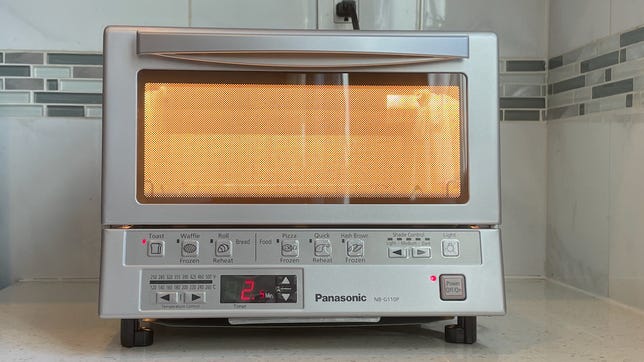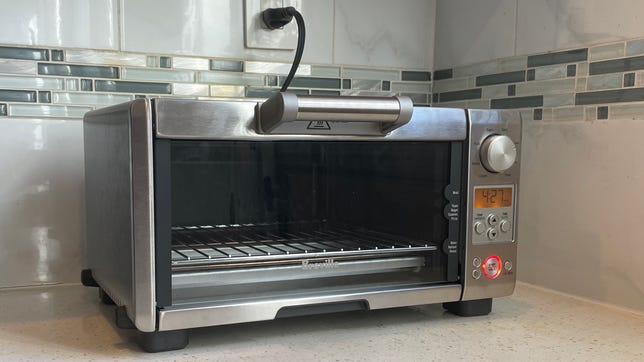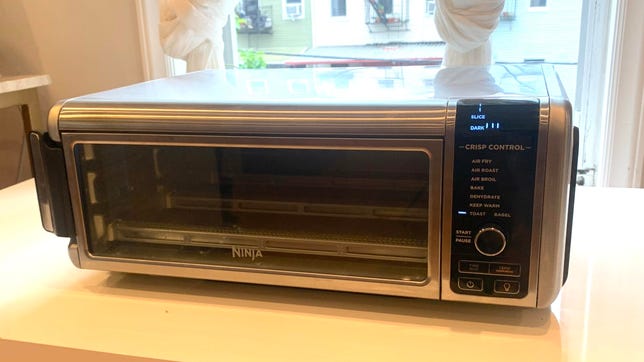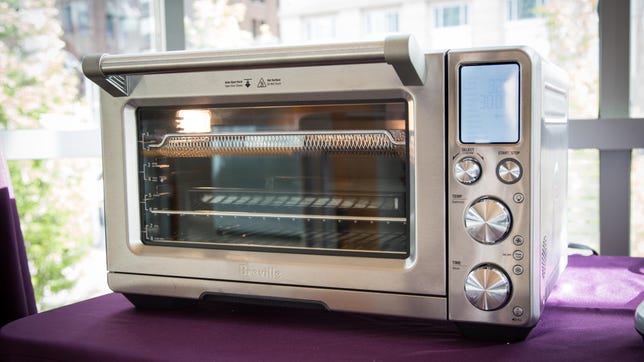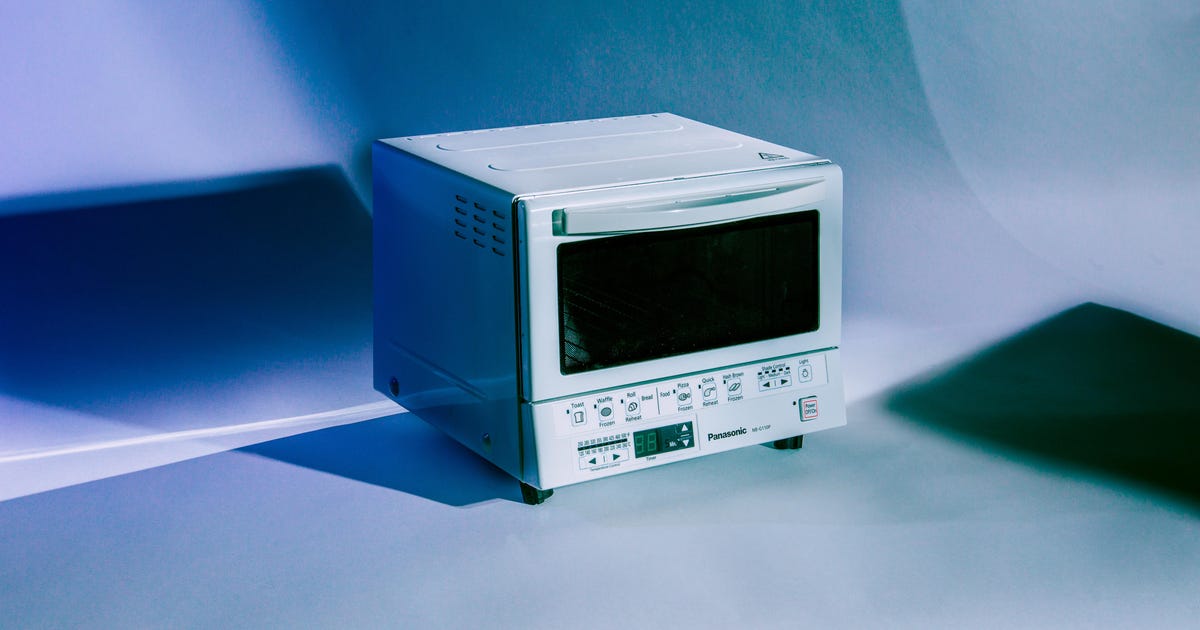
In this article:
While you may not think of a toaster oven as an essential kitchen appliance, they’ve become a popular mainstay for a reason. Not only are they faster and more convenient than a traditional oven, but many are just as versatile with the ability to toast, bake, and broil. They’re great for everything from reheating leftovers to whipping up complete. meals. Panasonic and Breville make some of the best models out there, but we’ve tested many more to bring you the best toaster oven of 2023.
Deciding which type you want is the first step in finding the best toaster oven in a sprawling sea of options. You can now tailor this small appliance by size, style, cooking functions and even smart-home connectedness. There are air-frying toaster ovens, freakishly fast models and large countertop ovens that can almost replace your full-size oven.
Countertop toaster ovens have gotten smarter and more precise than in years past, and you can rely on a good model to bake a small batch of cookies or personal pizza. But with so many to choose from, there are bound to be some over- and under-performers in the category. I hauled in ten models — and more bags of bread than I care to admit — in a mission to find the best toaster ovens in 2023.
Best toaster ovens
Panasonic
The Panasonic FlashXpress lived up to its moniker, toasting bread to an even golden-brown medium in just two and a half minutes. That’s the fastest time of any on the list, likely thanks to the infrared heating element, so it may be the best toaster oven for those who prize speediness.
I really liked the FlashXpress’ simple display and big buttons, and its easily-removable crumb tray. It has an eye-pleasing and vaguely futuristic design. This toaster is also unusually light, weighing just 7.5 pounds. Most of the other best toaster ovens of this size are double the weight.
On the downside, the FlashXpress has no convection mode, so it isn’t the best for baking a tray of cookies or more involved roasting and broiling. It also might not be big enough for everybody, and only holds one rack at a time. But even now, several years after we first reviewed it, the Panasonic FlashXpress is easy to recommend as the best toaster oven for basic toasting, baking and warming food.
You’re receiving price alerts for Panasonic FlashXpress Toaster Oven
David Watsky/CNET
The race for the overall best toaster oven was a true photo finish between the Panasonic FlashXpress and Breville’s capable Mini Smart Oven. Both toasted four slices of bread evenly, with doneness presets that deliver on their promise. The Breville, like the FlashExpress, also held its temperature well and preheated quickly.
The slightly more expensive Breville does sport a few functions that the Panasonic doesn’t, the most important being broil and convection modes. Breville’s Mini Smart oven has three levels at which you can slide a tray in, and the dials and settings allow for more precision than most ovens. A thoughtful “a bit more” button gives your food another minute of cooking time if it’s needed without having to reset the program.
Though usually the Breville Mini Smart Oven is priced at $160, which is about $10 dollars more than the FlashXpress generally sells for, it’s easy to find it on sale. It also weighs 15 pounds, which is twice as much as the FlashXpress, but still by no means heavy.
You’re receiving price alerts for Breville Mini Smart Oven BOV450XL
David Watsky/CNET
If it’s a countertop oven that doubles as an air fryer you seek, this Ninja model is likely the best toaster oven for you. The Foodi functions well as a toaster, quickly and evenly toasting bread and blasting a frozen empanada to golden-brown perfection, but it also sports a mighty air-frying function that’s on par with just about any we’ve tested.
The Ninja’s MSRP is $50 more than the Panasonic and $40 more than Breville, but if you were planning to buy an air fryer, you would save money overall, not to mention space on the counter. Speaking of countertop space: The Foodi smartly flips upright on a back hinge. When locked in the up position, it’s no more than eight inches from the back to front.
One drawback is the Ninja’s interior size, but I suspect that’s also why the air fryer mode works as well as it does. The Ninja is short — about 6 inches tall — so you’re somewhat limited in what you can put inside. It also makes things a bit clumsy when you’re loading food in and taking it out, and it’s harder to see while it’s cooking.
It typically lists for $240, but can often be found for closer to $200, which I view as solid value considering the quality, versatility and performance of this countertop oven.
Editors’ note: This model was tested previously as part of CNET’s list of best air-frying toaster ovens.
You’re receiving price alerts for Ninja Foodi Digital Air Fry Oven SP101
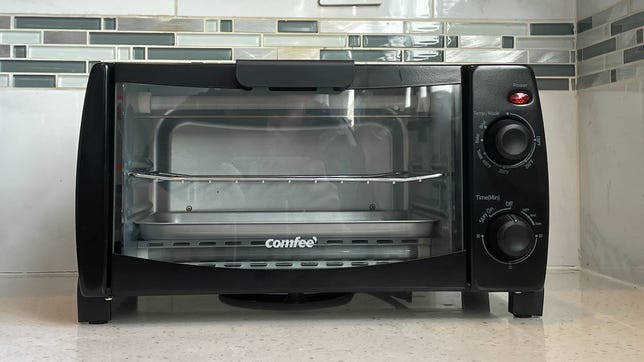
David Watsky/CNET
Comfee Toaster Oven CFO-BB101
Best budget toaster oven that gets the job done
Editor’s note: The Comfee CFO-BB101 has been discontinued. As an alternative, we’ve since tested the $40 Black & Decker 4-slice which provides even toasting performance at a wallet-friendly price.
If you’re looking for a basic toaster oven for your morning staples, the Comfee is simple, small and does the most basic toaster tasks well. It also held heat more consistently than any other oven, likely due to its small size and lack of a convection fan, which moves hot air around.
The Comfee clocks in at $45, which just might make it the best toaster oven option for those on a budget. Don’t expect anything in the way of fancy cooking modes, and it features simple manual dials to control the time and temperature. But it’s reasonably sturdy and toasted four slices of bread evenly in about four minutes.
My biggest complaint with this toaster is the rack placement. The tray is able to slide in either near the top or the bottom but not in the center of the oven, which does cause some top-to-bottom unevenness, but it wasn’t enough to really bother me. I also wouldn’t expect to use this oven for years. But if you need something fast and don’t want to spend much, the small yet mighty Comfee is a solid budget toaster option.
Chris Monroe/CNET
If you don’t have a real oven or you just really don’t like using it, this big fella can take on a lot of the tasks of a full-size oven. The Breville BOV800XL isn’t cheap at around $280, and there’s nothing “smart” about the smart oven in a cloud-connected sense, but it functions about as well as you could possibly expect from a countertop convection oven.
On top of that, the oven is sturdy, attractive and has an easily removable crumb tray, and it’s packed with extra cooking settings and modes that you might actually find useful, including convection cooking. It also preheats extremely fast, holds the heat well and has intuitive controls.
It’s a contender for being the best toaster oven for those who want a side oven for extra tasks. A very similar version of this oven with an air fryer function called the Smart Oven Air is available for around $350.
You’re receiving price alerts for Breville Smart Oven
Other toaster ovens we tested
- Hamilton Beach 31123D: The $90 digital toaster oven cooked four slices of toast evenly and has a sloping “Easy Reach” door that lifts up to help avoid burning your hand on hot glass. Overall, this basic toaster oven performed well and is a more budget-friendly alternative to the Panasonic FlashXpress and Breville Mini Smart Oven.
- Oster TSSTTVMNDG: This unit cost $120 but felt cheaply made as soon as I lifted it out of the box. Sure enough, one of the wire racks had already broken loose in transit. The dials were also clunky and not very intuitive. The toasting performance was satisfactory, although it didn’t brown as evenly as other models, and it takes a long six minutes to toast bread to medium.
- Balmuda Toaster: This trendy $299 option uses both traditional heating elements along with steam to keep bread and other items moist while cooking. The oven looks great and did an above-average job with toast. It’s also super fast and holds heat well, but it’s very small and thus hard to recommend at such a bloated price.
- GE Digital Air Fry Toaster Oven G9OAAASSPSS: This larger toaster oven sports a decent air fryer mode and did well in most of my testing. It takes longer than others to toast bread, and I wasn’t in love with the dials and display. It’s not a bad machine, but it costs $220. For an air frying toaster, I prefer the Ninja Foodi. And if it’s just a basic toaster oven you seek, there are definitely better and cheaper options.
- Cruxgg 072-09-0289: Besides a name that is impossible for the human tongue to pronounce, this toaster oven with air fryer mode was a bit of a flop. It burned the dickens out of bread when set to medium and toasted the four slices more unevenly than any other oven. It also costs $180, making it one of the more expensive models on the list.
How we test toaster ovens
I set out to cook a wide variety of common toaster oven fodder. With the exception of the toast tests, where I looked at each toaster oven’s individual settings for light, medium and dark toast, I used standardized temperature and cook times, and followed the recommendations on the box for whatever I was cooking wherever possible.
Toasting capabilities: Speed and consistency
Making toast is one of the critical tasks for a toaster. I mean, it’s right there in the name. I hauled in a whole lot of bread to see how fast and evenly each oven made this breakfast and sandwich staple.
Most low-end toaster ovens use a built-in kitchen timer to set the broiling, toasting and cooking time. Typically, those timers include a couple of preset options for toasting: medium toast, dark toast and in some cases, a setting for light, barely toasted bread, too. Higher-end models with an LCD display will usually let you dial into a specific doneness level when you’re toasting. You’ll typically get about six or seven settings to choose from with those, each with preprogrammed toasting times. That’s more precise than turning a timer knob, and worth it if you’re a stickler for the perfect shade of golden brown.
For my purposes, I toasted four slices of thin, white sandwich bread in each toaster oven on medium. The aim of this test was to see how evenly each oven toasts in all areas of the oven and how well-calibrated the medium toast setting is. Evenness is especially important when you’re making breakfast for a group. Ideally, you’ll want them all to come out looking as close to identical as possible.
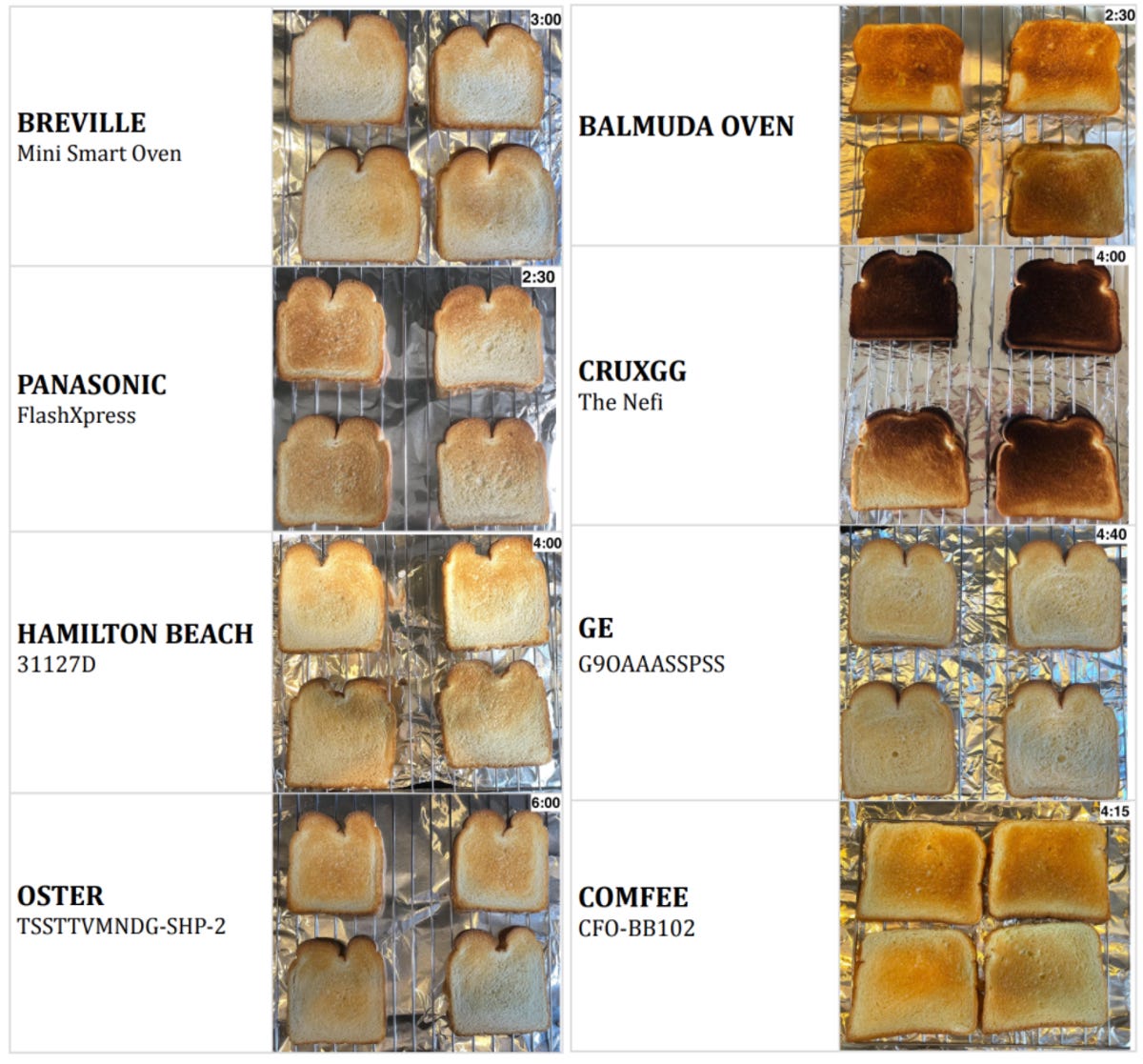
I toasted four slices of white bread on medium to test how evenly each toaster cooks and the calibration of its doneness setting.
David Watsky/CNET
I also tested two pieces of bread on the lowest doneness setting (light) and the highest (dark), to see how well these presets were calibrated. After each of the three toast tests, I photographed the results and made sure to let the toaster oven cool to room temperature before testing again.
For overall evenness, the results were surprisingly uniform across the board, with the exception of the Cruxgg, which toasted extremely unevenly. The Hamilton Beach, Panasonic’s FlashXpress and Breville Mini Smart Oven were among the top finishers with mostly even cooking and a solid medium color. The Balmuda also toasted four slices of bread evenly.
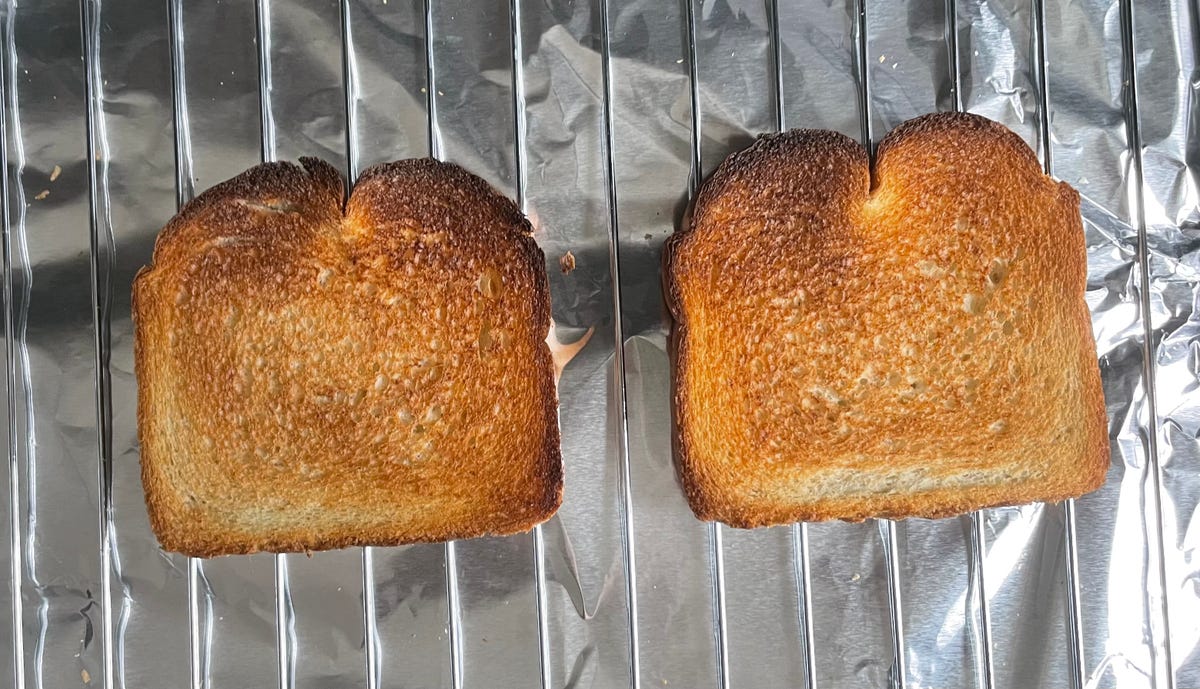
The Panasonic FlashXpress’ well-calibrated dark toast setting delivered a proper dark without burning the bread.
David Watsky/CNET
The FlashXpress also had the most accurately calibrated settings. The light setting delivered barely-there toasting while the dark setting produced proper dark pieces of toast without burning them. The Breville and Balmuda also nailed the light and dark toast cycles when I put them through their paces.
Besides the Cruxgg, which burned the toast, even when set to medium, none of the doneness presets were too far out of whack, although toast made in the Hamilton Beach was, oddly, about the same color for dark as it was for medium.
Cooking times
Speed was also a factor. I think we can all agree that, on a busy morning, the less time you have to wait for toast the better. I noted the time it took for each toaster to complete a cycle on each of the three settings: light, medium and dark.
In terms of pure speed, the infrared Panasonic was the fastest, living up to its FlashXpress nickname. It toasted to a nice medium in just 2.5 minutes. The Balmuda also toasted four slices in under three minutes, while the Breville Mini Smart oven did it in three. The slowest was the clunky Oster, which took well over six minutes to hit medium, followed by the GE, which took nearly five minutes and was still underdone.
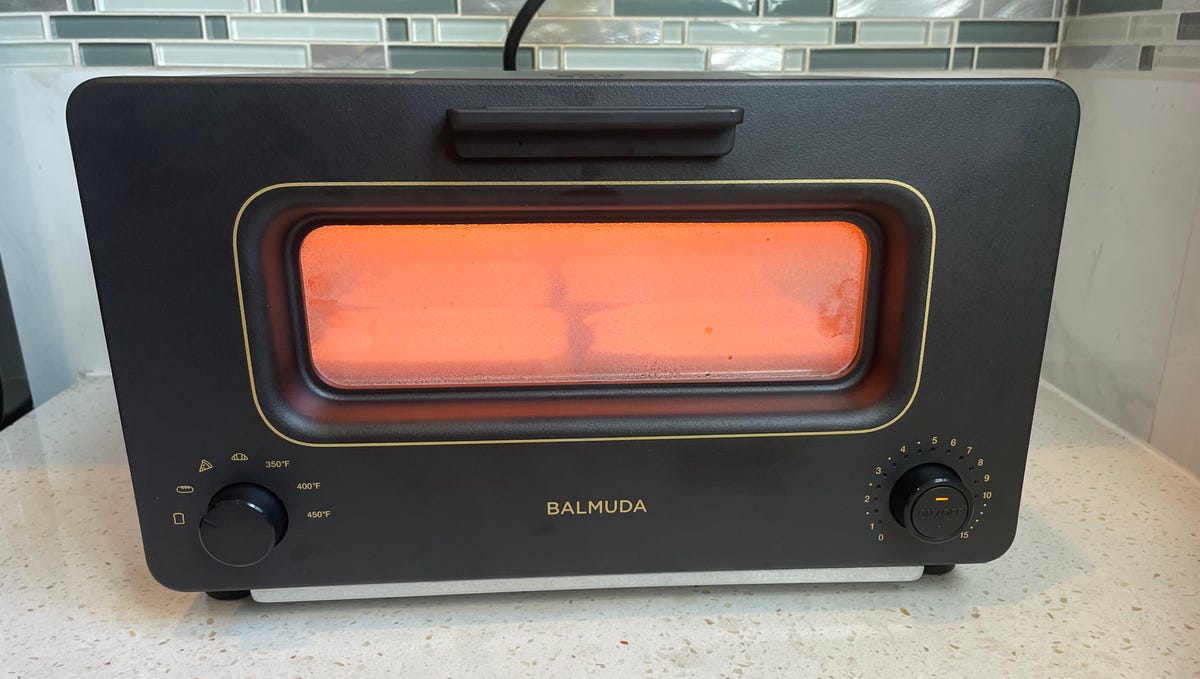
The $299 Balmuda toaster uses a bit of steam to keep things moist.
David Watsky/CNET
Temperature consistency and accuracy
If you plan to make things like cookies and pizza or use your toaster to make more complicated recipes, you’ll want an oven that holds its heat consistently over time. To test the consistency of each oven, I tested how much fluctuation each oven experienced when set to 300 degrees Fahrenheit over the course of 15 minutes. I used a RisePro thermocouple thermometer to measure the highest temp, the lowest temp and the average temp over the course of that period.
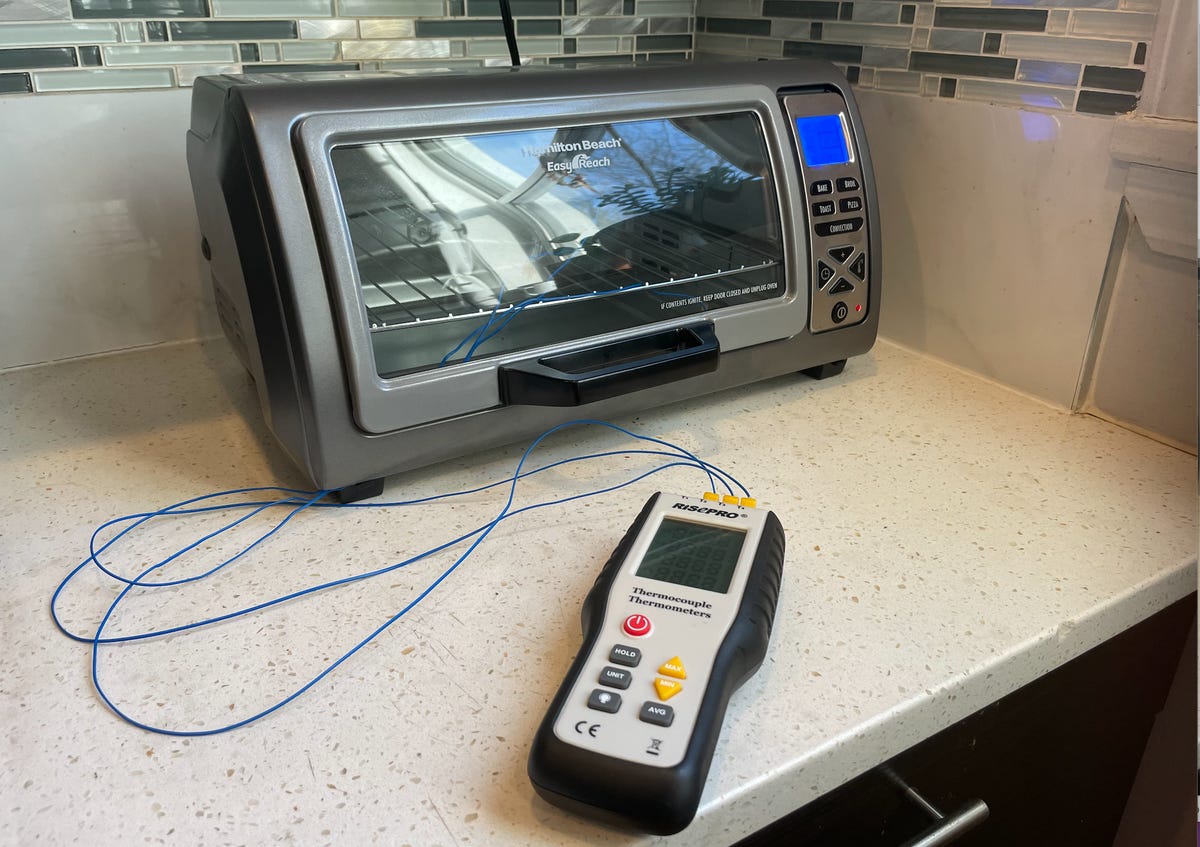
I ran each toaster oven for 15 minutes at 300 degrees F to measure the temperature accuracy and consistency.
David Watsky/CNET
All of the ovens performed fairly well in this test, with the exception of the Cruxgg. The Breville Smart Mini and Panasonic FlashXpress both held an average temp of 310, just 10 degrees more than the target temp which is a good mark for any oven. The Balmuda Steam oven can only be set to 350, 400 or 450 degrees F, so I ran the same test at 350 F. It also did well, running an average of just 12 degrees above the target temp.
In a shocker, the $45 Comfee toaster oven fluctuated the least — only 15 degrees from start to finish — placing first in the consistency test, but that is likely because it is both small and has no convection fan to stir the air up. The Comfee was fairly accurate too, although it ran an average of 22 degrees hotter than the temp I set it for. See full results below.
Temperature consistency
| Min. temp | Max. temp | Avg. temp | Difference from target | |
|---|---|---|---|---|
| Breville Smart Mini | 288 F | 327 F | 310 F | +10 |
| Panasonic FlashXpress | 261 F | 330 F | 310 F | +10 |
| Hamilton Beach | 268 F | 299 F | 284 F | -16 |
| Oster | 270 F | 319 F | 285 F | -15 |
| Cruxgg | 320 F | 363 F | 341 F | +41 |
| GE | 260 F | 340 F | 320 F | +20 |
| Comfee | 320 F | 335 F | 322 F | +22 |
| Balmuda (set to 350 F) | 320 F | 365 F | 360 F | +10 |
Testing the convection and bake functions
To test each toaster’s power and ability to cook more substantial foods, I baked three pizza bites placed on a rack in different parts of the oven. This was to test how accurately each toaster melts cheese and another test of how evenly the cooking is spread out across the oven. The box recommends baking a frozen pizza at 425 degrees F for 18 minutes, so that’s what I did in each toaster oven.
In addition to pizza bites, I cooked a frozen Jamaican meat pie in each oven as directed by the box: 25 minutes at 400 F. This test was designed to see how well an oven would cook a denser frozen food without burning the outside. We’ve all bitten into what appears to be perfectly browned and previously frozen food only to find it still frozen in the center. Not fun.
In the Jamaican patty test, all of the ovens heated the frozen meat pies through the center, but the Breville and Balmuda produced the best browning on the outer pastry shell. The hand pie that emerged from the Balmuda Oven (see below) was nearly overcooked (and perhaps it would be for some folks) but that’s just how I like mine.
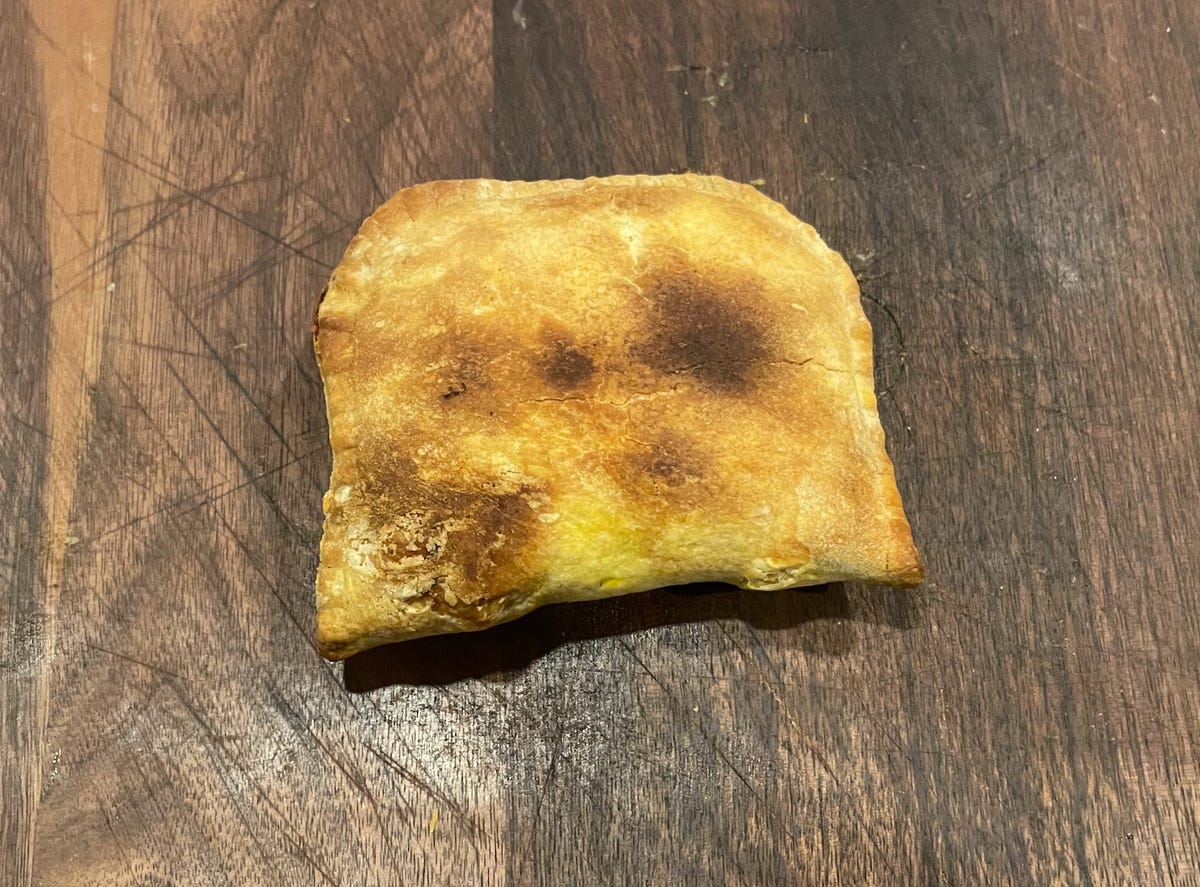
The Balmuda Oven delivered a hot center and lovely browning on this frozen Jamaican beef patty.
David Watsky/CNET
The FlashXpress just slightly overcooked the patty, while the Cruxgg burnt it well past edibility. While all of the ovens produced meat pies that were hot in the center, the least outer browning came from the Hamilton Beach toaster and Oster. Not surprising, considering both ovens both ran cool in the temperature consistency and accuracy test.
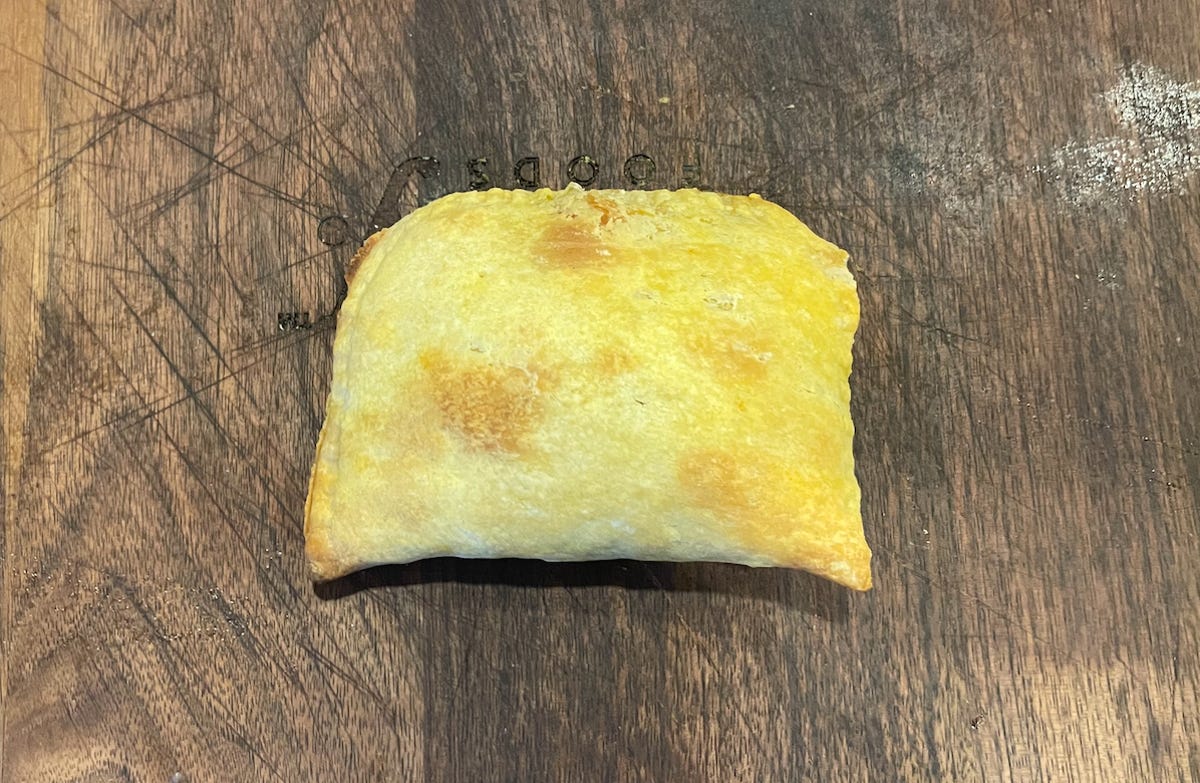
The Hamilton Beach ran a little cooler so it’s no surprise the Jamaican patty had less browning than other ovens I tested.
David Watsky/CNET
Toaster buttons and display
I found the toaster ovens with digital displays easiest to program since you dial into your preferred level of doneness on a six- or seven-point scale rather than guesstimating with a timer knob. My favorite display was on Breville’s Mini Smart Oven, which was simple and easy to use with dials that accurately adjust the cooking time for both doneness and number of slices. This model also has an “a bit more” button and a cool-down mode to stop cooking faster. I also liked the Panasonic FlashXpress’ display which is slightly simpler than the Breville with fewer special modes but more programs for specific items like one for frozen waffles, frozen pizza and even hash browns.
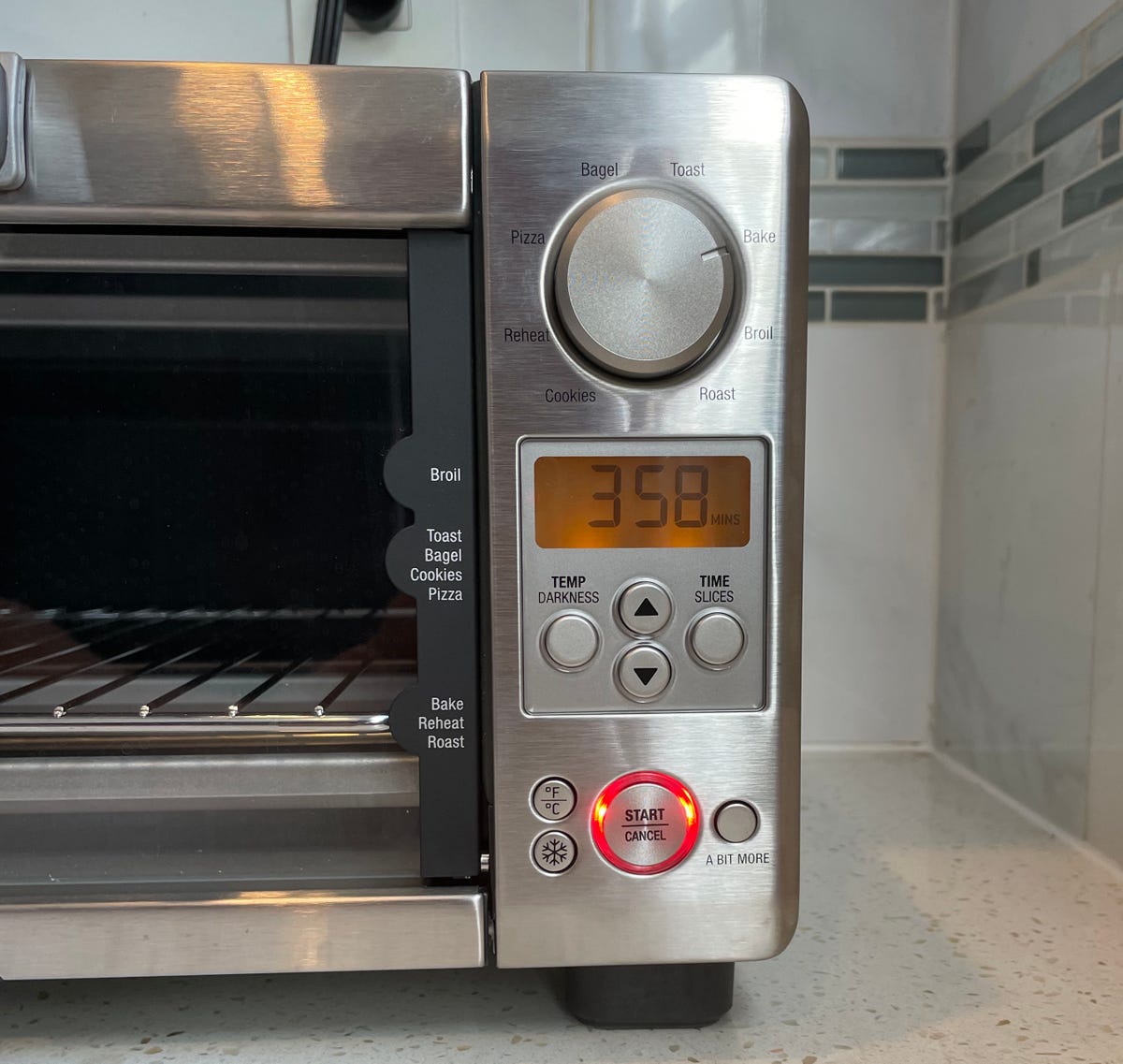
The Breville Mini Smart Oven had my favorite display out of the bunch.
David Watsky/CNET
In truth, I don’t find toaster oven cooking programs very helpful, and I rarely use them. Since every brand, be it frozen pizza, waffles or mozzarella sticks, vary in size and density, it’s generally best to follow the instructions on the box.
My least favorite display was on the Oster, which had one-dimensional backset buttons and a wonky digital screen that offers very little information. The buttons would often not react and required a forceful push, sometimes two. The super-cheap Comfee Toaster has manual dials and no display. Manual dials are difficult to set accurately both for temperature and time. They often make a ticking sound as well, which can be annoying.
Testing how easy each toaster is to clean
This was less of a cooking test and more of a cleaning test, but one that’s near and dear to my heart. Every toaster oven comes with an aluminum baking sheet with a nonstick coating, but some are much easier to clean than others. Because these sheets are mostly fitted to the oven, you’re sort of stuck using that one until you replace the toaster entirely, so it’s nice when they come clean and don’t stain or collect gunk after just a few sessions.
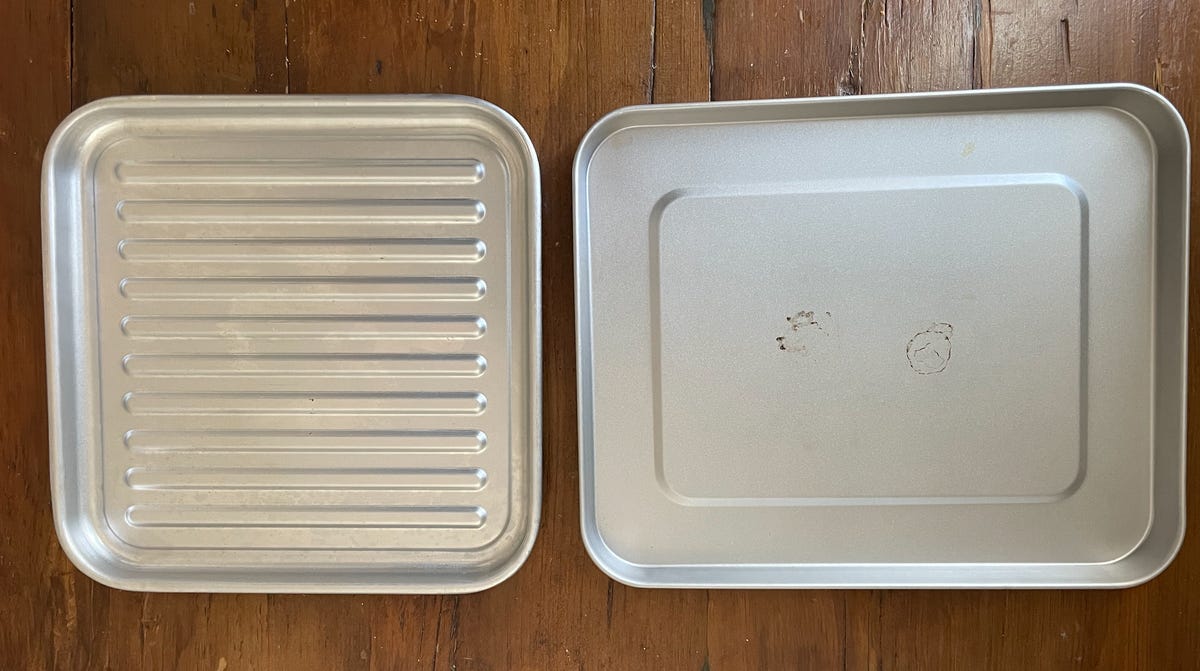
The baking tray that comes with the Panasonic FlashXpress was much easier to clean than the one that accompanies the Hamilton Beach.
David Watsky/CNET
After the pizza bites finished cooking, there was inevitably some spilled sauce and cheese left on the sheet. I allowed the pan to cool enough to handle without gloves and then scrubbed it vigorously for one minute using a sponge, hot water and Dial dish soap. The easiest baking sheets to clean belonged to the Breville Mini Oven (which is black, so that probably helps), the Panasonic FlashXpress and the $43 Comfee toaster.
The trays that came with the Hamilton Beach and GE Toaster remained the most stained after a minute of cleaning, with the rest falling somewhere in the middle.
Toaster oven specs
| Comfee CFO-BB101 | Hamilton Beach 31128 | Oster TSSTTVMNDG-SHP-2 | Panasonic FlashXpress NB-G110P | Breville Mini Smart Oven BOV450XL | Cruxgg Nefi 14985 | GE G9OAAASSPSS | Balmuda, The Toaster | |
|---|---|---|---|---|---|---|---|---|
| Energy draw (watts) | 1,000 | 1,400 | 1,300 | 1,300 | 1,800 | 1,800 | 1,200 | 1,300 |
| Settings | Toast, Bake, Broil | Bake, Broil, Toast, Pizza, Convection | Toast, Bake, Convection, Broil, Warm, Pizza | Toast, Waffle, Roll, Quick, Hash Brown, Pizza | Toast, Broil, Bake, Roast, Reheat, Pizza Cookies, Bagel | Toast, Bagel, Air Fry, Broil, Bake, Pizza, Cookies, Dehydrate, Warm, Reheat | Air Fry, Toast Bake, Broil, Convection, Warm, Proof, Roast | Toast, Artisan Bread, Pastry, Pizza |
| Toast time, medium | 4:15 | 4:40 | 6:00 | 2:30 | 3:00 | 4:00 | 4:40 | 2:30 |
| Exterior dimensions | 14.6 x 11.4 x 8 | 15 x 19 x 9 | 20 x 16 x 11 | 12 x 13 x 10 | 16 x 14.25 x 8.5 | 11.5 x 18 x 15 | 16 x 17 x 14 | 14 x 13 x 8 |
| Weight (pounds) | 7.68 | 13 | 20 | 7.5 | 15 | 16 | 21 | 10 |
| Key features | None | Flip-up door | Large capacity | Infrared heating | Precise toasting | Air fryer mode | Air fryer mode | Uses steam |
| Colors | Black, White | Gray | Black | Silver | Silver | Black, White | Silver | Black, Cream, Gray, Tan |
| Warranty | 1-year | 1-year | 1-year | 1-year | 1-year | 1-year | 1-year | 1-year |
| Price | $45 | $90 | $120 | $150 | $160 | $180 | $220 | $299 |
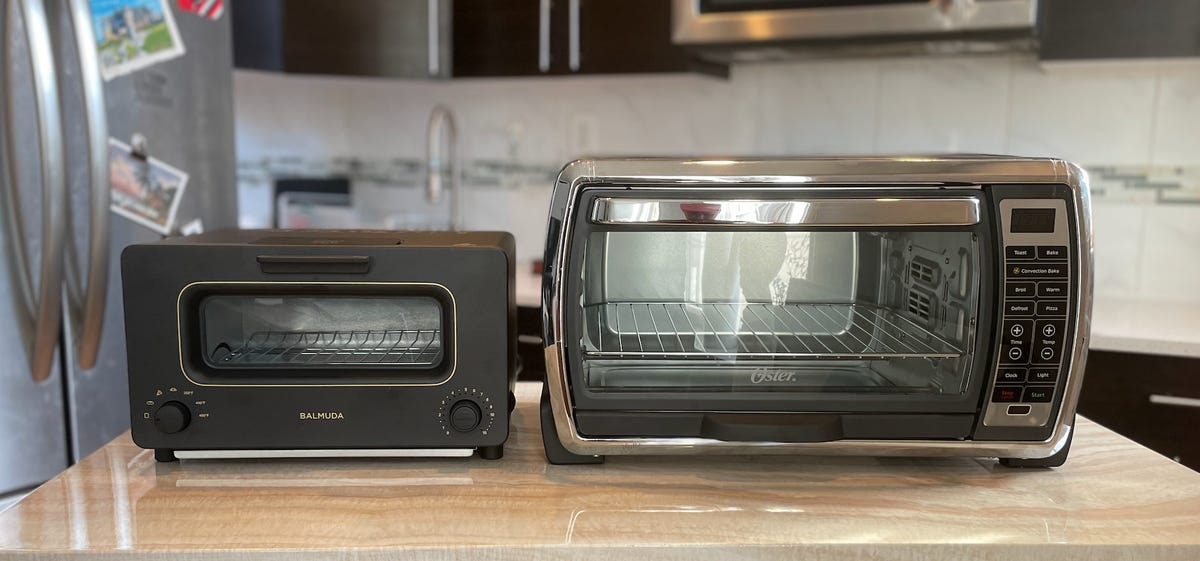
Be sure to consider the toaster’s size carefully before you buy. Here’s the big Oster, large enough to roast a small chicken, next to the itty-bitty Balmuda.
David Watsky/CNET
Toaster oven buying guide: Things to consider
Beyond performance, there are several considerations to make before buying a toaster such as size, functionality, design and overall value.
Size and capacity
Consider both the counter space you have to devote to your toaster and what you’ll typically use it to cook and how much of it you’ll be cooking. If you have four kids who all eat toast most mornings, a bigger model will save you from having to cook in batches. If it’s just you or one other house member, a smaller toaster model might be the better pick.
Features and settings
You’ll also want to think about what you’ll be using your toaster oven for most often. If you like toast with your coffee each morning, prioritize a toaster oven with a precise preset. If you like to broil things like hamburgers, make sure you get a toaster oven with a high top rack position just 2 or 3 inches underneath the heating elements. The Breville Mini Smart Oven, GE and Hamilton Beach are good examples of broil-friendly ovens.
Some of the temperature controls are more imprecise than others which may be a nuisance depending on how and what you plan to cook. The Balmuda can only be set in increments of 50 degrees, for instance, while the Panasonic FlasXpress in increments of 35 degrees. This didn’t bother me too much, but it does mean you can’t hit a precise 400 and thus may have to adjust for certain foods.
Design and construction
You will notice design flaws and clunky user interfaces, though, so if you can, head to the store and get your hands on the models you’re zeroing in on before you buy. Open and close the doors, adjust the racks and look for the little things. For instance, the wire rack that came with the Oster oven felt cheap. Upon closer examination, one of the wires had already snapped off in transit.
Another flaw to look out for is unusually short cords, a baffling design flaw that is more common than you might think. The Comfee and Oster cords were both only 2 feet long while the rest were 3 feet or longer. It certainly isn’t the worst failing for a toaster but, depending on your kitchen layout, can be an annoyance.
What about smart ovens?
There are also several smart ovens to consider that can do your toasting and a whole lot more. They are still relatively new to the market and in their early stages of design and production but one or more might be worth considering if you’ve got some extra money to play around with.
June Oven
I’m most intimately familiar with the June Oven, which now sells a third-gen model for around $899 (though is currently sold out). It’s a very capable cooking machine that uses built-in cameras to identify what you’re trying to make and a probe thermometer to nail the internal temps of meat and fish. It also offers cooking guidance and an abundance of settings to tweak in its companion app, but a premium subscription for that will run you another $10 per month. Read my full review of the third-gen June Oven here.
The Brava Oven is a capable connected cooker — but it costs $995.
Tyler Lizenby/CNET
Tovala Oven
The Tovala is another, smaller smart oven I’ve tested. At $299 (and currently on sale for just $99), it’s less expensive than the June oven but has fewer features and cooking modes. It doesn’t feature built-in cameras, for instance, instead, this smart oven uses a built-in QR code scanner to identify specific Tovala meal kits, as well as up to 750 frozen foods from retailers like Trader Joe’s. From there, the smart oven automates the entire cooking process. You just put the food in and press start. I tried this oven. I liked it and found it simple to operate, but would say it’s really only worth the money if you plan to buy a subscription for the Tovala meals it’s engineered to cook. Those run about $9 a pop and range from outstanding to just OK. Read CNET’s full review of an earlier-gen Tovala Smart Oven for a breakdown.
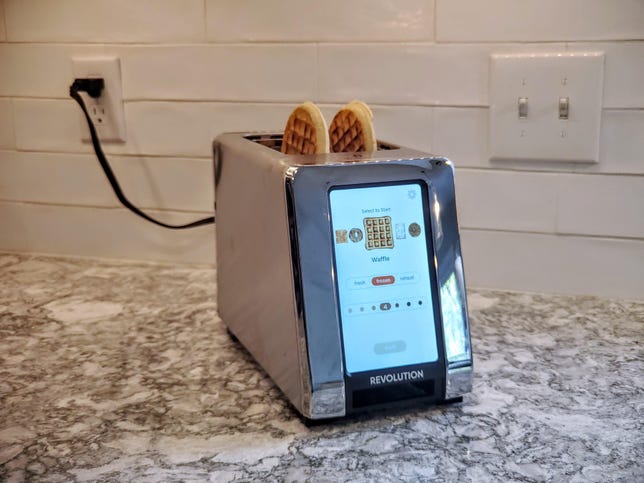
Revolutions speedy, toaster retails for around $350. You can often find it on sale for less.
Chris Monroe/CNET
Brava
The third smart oven worth mentioning comes from Brava, and it’s the most expensive of the three at $995. Among toaster oven upgrades, it’s a bit like Frankenstein’s monster — you get the same infrared heating elements as the Panasonic FlashXpress, the same built-in cameras as June, and the same meals kit approach as Tovala. Like the smart oven itself, those meal kits are awfully expensive, with dinner for two ranging from $28 to $45.
The Revolution Toaster
Heck, even plain old sliced bread toasters are looking to grab attention from smart home techies. The Revolution R180, a $350 toaster with a touchscreen on the front. Interestingly, that one uses diamond-shaped heating coils that are faster and more efficient than traditional toaster coils.I have to admit, the Revolution worked extremely well with lightning-fast speed when I used it. But no matter how you slice it, $350 is a whole lot of dough to drop on a slot toaster.
Toaster oven FAQs
What is the best size for a toaster oven?
The size of your toaster is another big differentiator and something to carefully consider. There are large countertop ovens that can fit a whole chicken and itty-bitty models best for bread and the odd frozen waffle or personal pizza.
The smallest oven we toasted was the Balmuda which fits only two slices of bread at a time with one rack position. The Breville Mini Smart Oven has the ability to hold at least two racks so you could, in theory, toast as many as eight slices of bread at once. Larger models like the Oster TSSTTVMNDG-SHP-2 and GE G9OAAASSPSS could fit a small whole chicken. Though I would probably recommend a big oven for something like that.
Figure out what size you’ll need so you don’t waste precious counter space. If you enjoy using your main oven for most baking, broiling and roasting then stick to a smaller unit. If you want a countertop oven you really cook with, consider spending a bit more on a bigger unit.
What are the different types of toaster ovens?
There are several sub-categories of toaster ovens that perform a series of different cooking tasks. One will likely suit you better than another, but you’ll have to think about how and what you want to cook with it.
The most basic toasters such as the Comfee use an electric or infrared heating element from above and below to toast, warm and bake. These budget-friendly models are often small and best for simple tasks like toasting bread or bagels, warming baked goods and cooking the occasional frozen snack.
Most midlevel and premium models include a convection fan to circulate air and cook food more evenly. The majority of the toasters we tested feature convection cooking which usually bumps the price up to about $80 or more. Convection cooking will give you more even heating for making cookies or pizza.
Fancier toaster ovens have special cooking modes including broil, roast, dehydrate and air fry. Don’t expect the same sort of proficiency as with a big oven. That said, the Ninja Foodi oven (from previous testing) came the closest to imitating those high-heat cooking methods with any type of success.
At the top of the pile are super tech-heavy toaster ovens also known as “smart ovens.” These are the priciest of the bunch, and models from names such as Tovala and Brava can cost up to $1,200. Smart ovens often include built-in cameras, probe thermometers and complex, integrated cooking programs you can control from your smart device.
Can a toaster oven save energy?
One argument in favor of countertop toaster ovens is that they use less energy than a full-size traditional oven. That’s true — most full-size electric ovens will draw about 2,400 watts at medium to high heat, while the average toaster oven will draw around 1,500 watts. That means that every time you’re using your toaster oven instead of your full-size oven, you’re cutting your energy consumption by a little over a third.
What does that mean in dollars and cents? Let’s walk through the math. Assuming an energy rate of $0.12 per kilowatt hour and an average use of 1 hour per day, the full-size oven will add about $105 to your energy bill each year. Unplug the oven and use a toaster oven instead, and that yearly energy cost drops to $65.
Your actual savings will vary based on use, and will likely be a lot less than $40. After all, most people who own toaster ovens will continue to use their full-size oven sometimes, if not most of the time, and hardly any of us will stop using our ovens altogether. So let’s split the difference and say that using a toaster oven instead of a full-size oven at least some of the time can knock as much as $20 off of your yearly energy bill, provided you’re baking something just about every day.
That’s still pretty good, but it’s also less than you might expect. Think about it — the average 1,500-watt toaster oven offers about 0.6 cubic feet on the inside, while the average 2,400-watt electric oven offers about 5 cubic feet. The toaster oven is 85 percent smaller, but it’s only using 35 percent less energy. If you’ve got a family to feed, or if you like to make multiple batches of cookies at a time, then you’ll actually get more value from the full-size oven.

